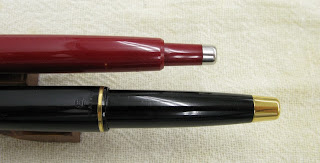I can find three categories among fountain pen manufacturing companies:
1. Companies that produce all the elements by themselves. Limited to Japan, Pilot-Namiki, Platinum-Nakaya, and Sailor belong to this group.
2. The second group is formed by companies that use nib and feed made by other companies and manufacture the rest—body and filling system. Nebotek, in Japan, is a clear example of this way of working—nibs and feeds are purchased from Bock, the pen body is turned out of the in-house ebonite, and the filling systems are devised and build by themselves.

A Bock nib made of titanium in a Nebotek pen. The section is made of the in-house ebonite (Nikko Ebonite).
3. Finally, pen companies in the third group buy nibs, feeds and filling systems —mostly cartridge/converters— made by some other companies. Their creations are then limited to turning and decorating the pen body and cap. Ohashido, Hakase, Stylo-Art Karuizawa certainly belong to this category. In fact, these companies buy complete pens from the big three Japanese companies and discard barrel and cap: Ohashido uses Sailor parts; Hakase uses Sailor and Pilot’s; Stylo-Art Karuizawa, Pilot and Platinum. Nebotek´s cartridge-converter pens could also be ascribed to this third group.

Hakase pen made of ebony wood. The nib is a size 15 made by Pilot. The ink converter is the CON-70 by Pilot.
It is fair to question the actual authorship of the pens of the last group—is an Ohashido pen so much more than a Sailor equipped with the same medium size nib? Are Hakase so much better than their Pilot or Sailor equivalents?
The paradox is that, more often than not, those making less (Hakase, Stylo-Art, Ohashido) sell their pens for much more than those manufacturing everything. Two reasons are often cited to justify these higher prices: One is the quality of the final nib tuning as done by the in-house nibmeisters. The second reason values the final beauty of these pens over that of the original Pilot, Platinum or Sailor. These pen-body makers often use urushi-coated ebonite, exotic woods, buffalo horns…
To the first reason it could be argued that the nib tuning can be made by many other people for much less money. In Japan, it would only take a visit to a Wagner meeting or to a pen clinic organized by those major companies in stationery shops and department stores.
To the second point the argument is easier, but also more personal: did you buy a pen or a jewel with a nib (::1::, ::2::)? Some still remember that the wise man follows the nib instead of the pen, but that might work only for those who write with their fountain pens. And this can be said for any pen brand in a moment in which jewels with nibs are a big part of the business.
Now, the possible conclusions derived from derived from this classification are up to the reader. On my side, I just want be aware of what I buy for our money.
Some more reflections were exposed on the Chronicle "Artisanal".
P. S: Around January 2014, Nebotek pens changed its name to Eboya.
Sailor Profit, Naginata Togi nib – Pilot Blue
Bruno Taut
June-August, 2013
labels: mercado, Pilot, Platinum, Sailor, Stylo-Art Karuizawa, Nebotek, Hakase, Ohashido, Bock
Bruno Taut
June-August, 2013
labels: mercado, Pilot, Platinum, Sailor, Stylo-Art Karuizawa, Nebotek, Hakase, Ohashido, Bock





























































